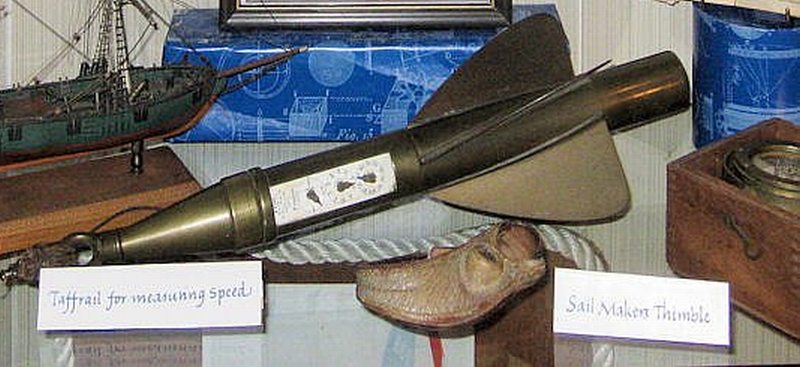Ships
and the Sea
A 2009 Display Case Exhibit - About the Display Case Committee
The Taffrail Log - by Steve Denham My early recollection of the taffrail log is one of my first memories. It hung on my grandparents' dining room wall in Brooklyn, NY. I was a toddler, and it was bright and shiny, so I naturally wanted to play with it. Since it was practically indestructible, Granddad was happy to (continued below) |
|
oblige if for no other reason than get me out of his hair. When he died, the log went to his son, my Uncle Buster. Years later, when Uncle Buzz moved to Florida, he presented it to me. I have no idea how my Grandfather came into possession of the log. He worked as a chauffeur for most of his life, with time-outs for WWI and WWII when he worked at the Brooklyn Navy Yard as a welder. My mother couldn’t give any clues either, except that “It was always hanging on the wall.” The taffrail on a ship or boat is the railing that runs across the stern (back) of the vessel. It’s about as far aft (to the rear of the boat) as you can go without getting wet. In the old days of sail, logging the speed of the vessel was accomplished by dropping a buoyant object off the forward side of the ship and timing how long it took to go a measured distance. This was replacedby dropping a float from the stern (taffrail) that was attached to a line with knots in the line at measured distances. Measuring the number of knots for a known time, or the time for a counted number of knots, could easily be calculated for speed. The speed of watercraft (and aircraft) is measured in “knots” to this day. Distances are measured in “nautical miles 6076 feet), so one “knot” is one nautical mile per hour. And we DON’T say “Knots per hour.” A knot IS a autical mile per hour. The online dictionary and encyclopedia show that the “Taffrail,” “Patent,” or “Screw” log was invented around 1800. It was configured as my log, a self contained unit with internal measuring devices. It was towed behind the ship and periodically retrieved and readings taken. Around 1870, new models were developed. They kept the trailing rotator device (which looked much as my log) and moved the measuring dials to the ship. This allowed a constant and readily available indication of the ship’s speed. The speedometer (or rather, the ship’s knot meter) was born. Most logs were apparently made in England, as this log was. My estimate would be a late model of he early, single-unit logs manufactured between 1800 and 1870. Let’s guess about 1865. |

